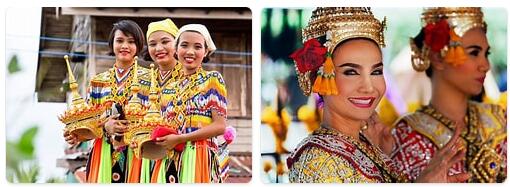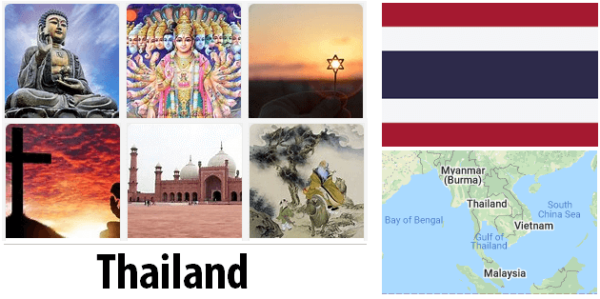Archaeological studies have revealed that the area that today constitutes Thailand has been inhabited for at least 20,000 years. Around the 10th century, various Thai speaking people emigrated from Central Asia to the south. During the 13th century, two Thai states emerged. The Suhkothai Kingdom was founded around 1220 after a successful uprising against the Khmer kingdom (see Cambodia). The state of Chiang Mai was founded in 1296 and in 1350 Suhkothai was replaced by the Aytthaya kingdom, which once again dissolved the Khmer kingdom which was about to disintegrate.
The Burmese were the strongest rival to the Aytthaya kingdom. In 1569, the forces of Aytthaya were defeated by the Burmese who conquered the capital and for 15 years ruled the country. In 1767 the Burmese once again conquered the capital of the Thais and brought down the Aytthaya dynasty.
In 1782, Rama I founded the Chakri dynasty – which continues to rule the country – and moved the capital to Bangkok (Krung Thep). Rama III extended the Thai empire to the south, encompassing the entire Malay Peninsula, to the north into Laos, and to the southeast into Cambodia.

Throughout the 19th century, British and French fought for control of the area, but in 1896 both colonial powers entered into an agreement to preserve the kingdom’s formal independence while continuing their rivalry over the country’s agricultural resources. However, the influence of the colonial powers also led to some modernization of society. Slavery was abolished, public schooling, railways and telegraphs were introduced. Central government was centralized and a comprehensive state bureaucracy was developed. It was recruited from the traditional feudalist democracy, which underwent European education to meet the demands of the new age. At the same time, the military was developed and modernized. The form of governance during this period was almost enlightened. All the political power remained in the king’s hands. Under 1.The League of Nations.
Gradually, the monarchy came into conflict with the new class of officials, and in 1932 the monarchy was abolished by a bloodless coup. The country was transformed into a constitutional monarchy by Western European pattern, forming a parliament elected by universal suffrage. However, contradictions quickly emerged within the new ruling layer: the first government under Pridi Phanomyong, supported by the progressive elements of civilian bureaucracy, had to step down after just a year. Instead, a Pibul Songgram Conservative government took over – dominated by the military. In 1941, the Conservative government allied with the Japanese to avoid Japanese invasion, and occupied parts of Malaysia during the war.. When it became clear that the Japanese would lose the war, Pridi once again seized power, reconciled with the Allies and initiated a democratization. In 46, the occupied territories were delivered back to the British who were colonial lords in Malaysia. Democratization, however, lasted briefly. In 47, Pibul returned to power with support from the United States.
American satellite
In June of that year, King Ananda Mahidol died in circumstances that have never been clarified. The US succeeded in placing his brother Rama IX on the throne. Born in the United States, he never hid his sympathies for this country. In the years that followed, Thailand evolved more and more into a North American satellite. A development that particularly accelerated and reached its peak in the 60s. In 1957, Pibul was ousted by the military and a purely military dictatorship was introduced. The country experienced strong economic growth during these years due to large North American investments, but the development was unilaterally concentrated in the Bangkok area, where a number of new industries sprung up. The profits went predominantly to the foreign major corporations that controlled this development and to a national citizenship – with strong military elements – attached to these interests.
According to thesciencetutor, Thailand became a North American satellite: as early as the 1950s, the United States systematically supported the building and modernization of the Thai army, and from the mid-1960s the North American military “presence” became even more concrete in the form of a series of aircraft bases and large troop forces – approx. 50,000 men. Already in 1954, the superpower had made Bangkok the headquarters of SEATO (South East Asian Treaty Organziation) – a military alliance with the participation of the Southeast Asian countries and the United States to curb the revolutionary development of the region. In 1961, large North American troop forces were sent into the country to fight the popular uprising in Laos. Throughout the 1960s, Thailand became one of the most important North American support points for the Vietnam War, and Thai soldiers fought on the United States in both Korea and Vietnam.
Yellow shirts and red shirts
After the People’s Party election campaign, 2008 was a very turbulent year with political power struggles and massive, violent street demonstrations. Under the leadership of Samak Sundaravej, the People’s Party had profiled their close ties to the fugitive Thaksin Shinawatra. It now formed a majority government in the form of a six-party coalition. But in September 2008, Samak was disqualified by the Constitutional Court: He continued as a TV chef in some programs after becoming prime minister, something the court found to be illegal. Deputy Prime Minister Somchai Wongsawat took over the Prime Minister’s post. Like Thaksin’s brother-in-law, he was also regarded as his political deputy, and immediately became the object of the “yellow shirt” protests.
The conditions were particularly chaotic towards the end of 2008. The Anti-Thaksin movement, which called itself the People’s Alliance for Democracy (PAD), paralyzed central parts of Bangkok for months with its massive protests. Somewhat paradoxically, many in the People’s Alliance claim that Thailand is not ripe for Western democracy. On the other hand, they advocate a “controlled democracy” in which the military has a role as a political order power.
The People’s Alliance’s “yellow shirts” kept the government building occupied to push the Somchai government to resign. The riots culminated in November, when the yellow shirts occupied and blocked Bangkok’s new main airport, Suvarnabhumi. They also took over the old airport, Don Muang, where the Somchai government had established with provisional offices. The airport occupation caused over 300,000 tourists to be stranded for days.
The airport occupation ended when the Constitutional Court issued a new ruling on December 2: The People’s Party had been found guilty of voting in connection with the December elections. On December 15, 2008, Parliament elected the leader of the Democratic Party, Abhisit Vejjajiva, to Thailand’s fourth prime minister in one year.
Some defectors from the Thaksin camp now joined parties that supported the Democratic Party, which could gather a majority behind it. The situation was still unclear and unstable, with no sign of national reconciliation. A new massive protest movement has now plunged into the streets with red shirts as a hallmark. The red shirts from the pro-Thaksin movement called themselves the National Front for Democracy Against Dictatorship, the National United Front of Democracy against Dictatorship, UDD. By blocking the parliament building, they managed to delay the accession of the Abhisit government.
The turmoil flared up again in March / April 2009. The National Front red shirts blocked the central government buildings in Bangkok for weeks. They also halted a scheduled summit in the ASEAN federation by storming the conference rooms in Pattaya. The rebel police failed to deal with the red shirts, and as a host, the Abhisit government suffered a severe “loss of face”. The heads of government from 12 Southeast Asian countries had to be evacuated by helicopter.
During the riots, Thaksin Shinawatra came from his exile in Dubai with a call to his followers to go out into the streets and revolt. On this basis, an arrest warrant was issued again, and Thaksin was charged with, among other things, having financed the unrest. He thus faces up to 12 years in prison if he returns.
Thaksin, by the way, had returned from exile after the People’s Party’s election victory in 2007. He resumed exile in 2008 after being tried in court with his wife, Khunying Potjaman. In October 2008, he was sentenced by the Supreme Court to two years in absentia for abuse of power in connection with his wife’s purchase of public land. Khunying’s husband was jailed for three years. Thaksin argued that the judgments were politically motivated. From his exile life, he still has his political outlook, and is thus still a central figure in Thai politics. He is reportedly still Thailand’s richest man, but much of the family wealth, probably about $ 14 billion, has been blocked by the authorities.
In March 2010, the UDD and the red shirts mobilized again. They demanded that Abhisit Vejjajiva dissolve the National Assembly and announce new elections. Abhisit was accused of lacking legitimacy as he had won no election but was appointed by parliament when the People’s Party PPP in December 2008 was dissolved by the Constitutional Court. Several red-shirt leaders also went hard and accused the King of political interference.
In April 2010, there was a clash between red-shirt protesters and security forces. 28 people lost their lives in the period 10-15. April. In May, the protests escalated again and the red shirts occupied central parts of Bangkok. On May 19, the army intervened against the protest camp. It was shot sharply and the leaders of the UDD were arrested. At least 52 people were killed in the period 14-19. May and around 50 civilians are still missing.
